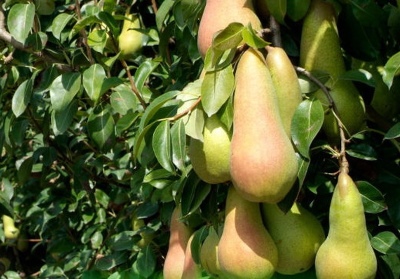
- Authors: England
- Appeared when crossing: Deccan du Comis x Conference
- Name synonyms: Concorde
- Fruit weight, g: 200-240
- Ripening terms: early winter
- Fruit picking time: late September - early October
- Growth type: medium height
- Yield: high
- Marketability: high
- Height, m: 3
Recently, frost-resistant pear varieties have been in high demand, especially in regions with cool summers and unstable weather conditions. A striking representative of frost-resistant species is the Concorde pear.
Breeding history
The Concorde pear look was bred by a group of English breeders in 1969. Such pear species as Conference and Decanca du Comis became the genetic basis of the variety. It is recommended to grow a fruit tree in any climatic zone, including the West Siberian and East Siberian regions.
Description of the variety
Concorde is a medium-sized tree that grows up to 3 meters in height. The fruit crop is characterized by an arbitrary or pyramidal crown shape with an average thickening of dark green leaves, semi-spreading branches that extend from the trunk at an acute angle, and an incredibly attractive appearance during flowering. The pear blooms at a later date, covered with white-pink flowers, emitting a pleasant aroma. The fruits are formed on the ringlets.
Fruit characteristics
Concorde is a representative of large-fruited pears. The average fruit weight is 200-240 grams. The shape of the fruit is classic - elongated pear-shaped. At the stage of removable maturity, the fruit is evenly covered with a dark green color. At the moment of consumer maturity, the color of the fruit changes and becomes rich yellow. The surface of the pear is decorated with an orange blush that appears from the sunny side. No rusting on the skin of the fruit is observed. The peel of the fruit is smooth, rather dense, but without hardness. The fruit is covered with a slightly oily sheen and blurred subcutaneous dots.
The variety is characterized by good transportability and long shelf life - up to 4-6 months (depending on storage conditions). In addition, Concorde pears have a universal purpose, so they are eaten fresh, widely used in cooking, canned, pickled, processed into marmalades, jams, and preserves.
Taste qualities
The fruit has excellent taste and marketability. The white-cream flesh is moderately dense and fine-grained. And also in the pulp you can feel a delicate and crunchy texture, complemented by incredible juiciness. The pear has a harmonious, full-bodied and attractive taste. Sweetness dominates the taste, complemented by sourness and sweet-sweet aroma.
Ripening and fruiting
Pear Concord belongs to the category of early winter varieties. Fruiting begins 3-4 years after planting. The culture bears fruit annually, without gaps. The period when you need to remove the fruits falls on the end of September - early October. The consumer period is somewhat extended - it can last about 5-6 months.

Yield
The variety is distinguished by excellent yield indicators.With proper agricultural technology and favorable conditions, about 100 kg of ripe fruits can be harvested from 1 tree per season.
Self-fertility and the need for pollinators
In order for the fruit crop to please with stable and abundant yields, it is necessary to plant pollinating trees nearby, in which the flowering dates coincide with the Concord pear. The best donor trees are: Favorite Clapp, Verdi, Good Louise, Abbot Fetel, Williams summer.
Landing
Planting pear seedlings can be carried out both in spring and autumn, but it is the autumn planting that is most effective. Autumn planting is usually done in the first week of October, one month before the frost stable. In spring, the tree is planted at stable air temperatures of 15-18 degrees Celsius. In this case, the soil should warm up to 10-13 degrees.


Growing and care
To get stable yields, it is recommended to provide the tree with proper care, as well as plant a seedling in the right place. The soil for the pear should be loose, fertile and breathable. The site should be sunny and far from outbuildings and tall fences. In addition, the passage of groundwater must be deep, since the root system of a pear goes 7-8 meters deep, and the tree does not like stagnant moisture.
As for care, it consists of watering, fertilizing, cutting branches and forming a crown, installing a support for the seedling, preventive measures that protect against insects and viruses: spraying with fungicides and insecticides, painting the trunk with lime, processing with a solution with copper sulfate.



Disease and pest resistance
Pears have a high immunity, so the tree is practically not susceptible to common diseases, for example, scab. The variety has average resistance to monilial burn. Timely insecticide treatments will help protect against insect infestation.

Like any other fruit trees, the pear needs protection from various diseases and pests. When planting a pear on your site, you need to know in advance what diseases you should beware of. To successfully carry out the struggle, it is necessary first to correctly identify the cause of the problem.It is important to distinguish signs of disease from manifestations of the presence of insects, mites, caterpillars and other types of pests.
Resistance to soil and climatic conditions
Due to its excellent stress resistance, the pear easily tolerates temperature fluctuations, large drops in temperature, short shade and drought. The pear loves warmth, but prolonged exposure to direct sunlight can burn the foliage.





































































